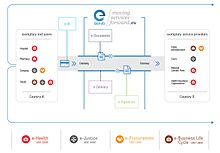
The term digital single market refers to the policy objective of eliminating national or other jurisdictional barriers to online transactions, building on the common market concept designed to remove trade barriers in other commercial fields.[1]
On 6 May 2015, the European Commission, led at the time by Jean-Claude Juncker, established the Digital Single Market Strategy, intended to remove virtual borders, boost digital connectivity, and make it easier for consumers to access cross-border online content across the European Union.[2] The Digital Single Market, which is one of the Commission's 10 political priorities, aims to fit the EU's single market for the digital age, moving from 28 national digital markets to a single one,[3] and then opening up digital services to all citizens and strengthen business competitiveness in the digital economy.[4] In other words, the Digital Single Market is a market characterized by ensuring the free movement of people, services and capital and allowing individuals and businesses to seamlessly access and engage in online activities irrespective of their nationality or place of residence. Fair competition conditions and a high level of protection of personal and consumer data are applied.[5]
Building a data economy, boosting competitiveness through interoperability and standardisation, and creating an inclusive e-society can realise the growth potential of the digital economy. According to the commission, investment, the acknowledgement of international dimension, and effective governance are required for the advancing of the Digital Single Market.[6] A fully operational Digital Single Market could bring a contribution of 415 billion euros per year to the economy and it would also create hundreds of thousands of new jobs.[7] The Digital Single Market Strategy includes a series of targeted actions based on 3 pillars. From these 3 pillars will come 16 key actions that constitute the Digital Single Market Strategy.[7]
- ^ Cite error: The named reference
ubiqwas invoked but never defined (see the help page). - ^ European Economic and Social Committee, "The digital single market - trends and opportunities for SMEs (own-initiative opinion)", published on 18 September 2020, https://www.eesc.europa.eu/en/our-work/opinions-information-reports/opinions/digital-single-market-trends-and-opportunities-smes-own-initiative-opinion, accessed on 17 April 2021.
- ^ EUROSTAT, "What is the Digital Single Market About?", website of Eurostat, https://ec.europa.eu/eurostat/cache/infographs/ict/bloc-4.html, accessed on 18 April 2021.
- ^ EU Agenda, "Europe's Digital Single Market Strategy: One Year In", EU Agenda website, https://euagenda.eu/publications/europe-s-digital-single-market-strategy-one-year-in, accessed on 15 April 2021.
- ^ Cite error: The named reference
:1was invoked but never defined (see the help page). - ^ European Savings Banks Group, "Digital Single Market", website of the ESBG, https://www.wsbi-esbg.org/Positions/Payments/Pages/DigitalMarketStrategy.aspx Archived 11 April 2021 at the Wayback Machine, accessed on 21 April 2021.
- ^ a b SPF Economie, "Stratégie pour un marché unique européen", website of the SPF Economie, last update on 31 March 2021, https://economie.fgov.be/fr/themes/line/strategie-pour-un-marche, accessed on 22 April 2021.